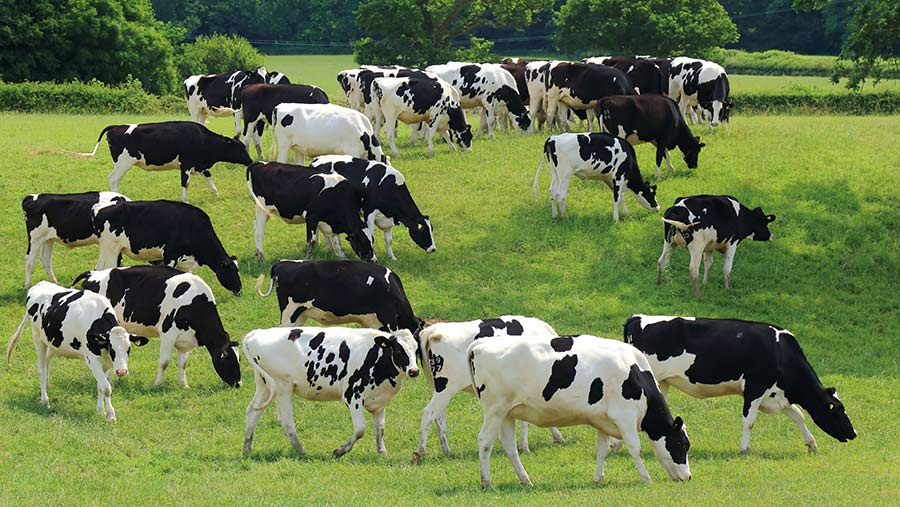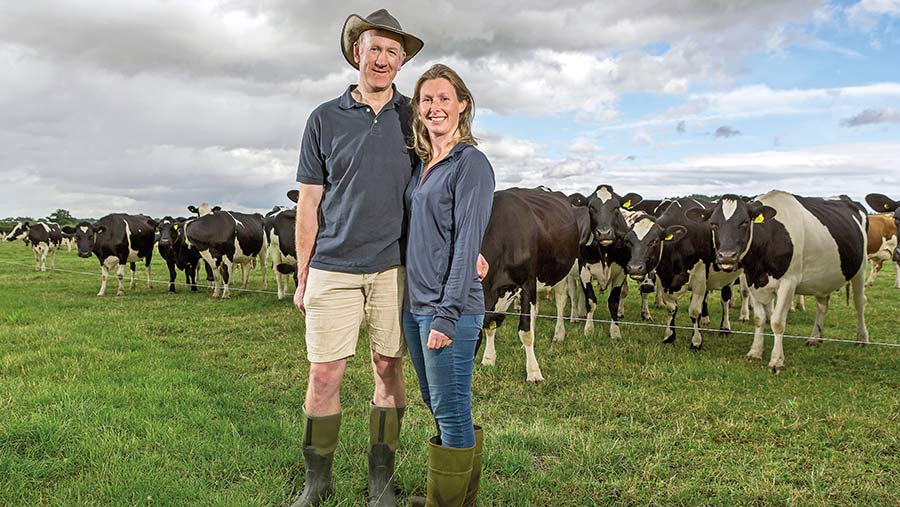Organic dairy farming in 2022: Opportunities and challenges
 Savo Ilic/Adobe Stock
Savo Ilic/Adobe Stock The value of the UK organic dairy sector has remained fairly flat over the last five years, with consumer demand in the UK behind many other developed nations.
Despite this lack of growth, David Williams, chief executive at organic milk co-op Omsco believes there is a good future in organic dairy, and longer-term potential for a great future.
We take a look at the size of the current market, how this is likely to grow, and what it could cost to convert to organic.
See also: Business Clinic: what are the tax issues on selling stock
Organic milk remains a small share of the wider market, accounting for between 3% and 5% of all milk deliveries.
Organic numbers
- In 2021, there were 59,300 organic dairy cows in the UK, with 47,200 head in England, according to Defra.
- Overall, UK organic cattle numbers were estimated at 295,600 head.
- A total of 506,600ha of land in the UK was farmed organically in 2021. Of this, 61% was permanent grassland and 9% used to grow cereals.
- The total UK organic market was valued at £1.4bn for the 52 weeks ending 26 December 2021, up 1.4% on the previous year, according to retail analyst Kantar.
- While just 1.2% of the national diet is organic produce, data from Kantar shows organic dairy accounted for 30.8% of the total spend on organic food.
Current market
The milk marketing year from April 2021 to March 2022 saw a total of 487m litres of organic milk delivered to processors, down by 5.9m litres on the 2020/21 milk year, according to provisional estimates from the AHDB.
This was equivalent to a 1.2% decrease in organic milk deliveries, compared with a fall in conventional milk supply of 0.7% during the same period.
More recently, the daily average for organic deliveries was 1.45m litres for the week ending 7 May, with deliveries 6.9% below the same week last year, equivalent to 108,000 litres a day.
Per capita spending on organic products is much lower in the UK than in many other developed nations.
This could offer a real opportunity for growth, according to Mr Williams, who believes there is a good future in organic dairy, and longer-term potential for a great future.
“The organic sector in the UK is currently significantly underperforming in terms of market share for both cheese and liquid milk compared with Germany, France and Denmark,” he said.
The UK is a net exporter of organic products and has a heavy reliance on European and US markets, which account for about 80% of the global organic market.
The EU aims to have 25% of agricultural land farmed organically by 2030.
If it is successful in meeting this target, this could have a significant effect on the market for UK organic exports.
Industry players
Omsco accounts for more than half of the UK’s organic milk supply, processing more than 250m litres a year from about 250 suppliers.
The business has a turnover of about £100m and supplies much of the UK’s organic market, as well as exporting a range of products such as cheese, bulk ingredients and whey to key markets including the US.
Arla is another major player in the organic sector and is currently targeting 50% growth of its organic dairy business by 2026, which would take it from 180m to 270m litres through increased production from its existing producers.
Arla Foods managing director Ash Amirahmadi believes consumer demand for organic dairy products will continue to grow in the UK, as well as in other parts of Europe.
Price challenge
However, the organic milk price has been struggling to keep up with the rate of price growth seen in conventional milk prices in recent months.
Dairy market analyst Chris Walkland says: “The organic sector price has gone up at half the rate of the conventional milk price.”
Historic farmgate price premiums for organic milk have traditionally been about 25% to 30%, whereas currently they are closer to a 12% to 15% premium over conventional prices, according to Daykin Partnership.
The narrowing of this gap is illustrated by Arla’s May 2022 price for a conventional standard manufacturing litre at 43.30p, while its organic members are receiving 49.58p/litre.
This compares with 32.79p/litre (conventional) and 41.15p/litre for organic milk in May 2021.
Feed costs
With a strong focus on forage, organic systems require increased access to grazing, and cattle can be outdoors for between 120 and 200 days a year.
However, spending on other feed costs is often much lower than conventional systems.
Dairy consultant Ainsley Baker says the average organic dairy cost of production is being increased by very significant rises in feed costs as a result of Russia’s invasion of Ukraine, limiting access to key ingredients used in organic dairy rations.
Mr Baker, who is a partner in Kite Consulting says: “There is a wide variation between the highest and lowest paying organic milk buyers. At the lower end, the average producer will be struggling to keep their cost of production below the milk price they are receiving.
“Feed use for most organic dairy farms is currently low while producers make the most of grazed grass.
“Alongside other cost increases on farm, the key challenge will be this winter, when compound feed costs could rise by more than £150 a tonne compared with last year, significantly increasing the average cost of production for organic milk.”
Producing sufficient high-quality forage from home-grown sources, really well managed grazing platforms and an uncompromising approach to cow health and fertility will be more important than ever this year for organic dairy producers, according to Mr Baker.
In February 2022, the average margin over purchased feed for all farm types was 25.51p/litre, compared with 21.33p/litre in February 2021, according to Promar’s Milkminder monthly report.
No figures were available separately for organic dairy, however non-organic farms averaged a margin over purchased feed of 25.36p/litre, which is slightly lower than the figure for all farms, implying the margin for organic farms was slightly higher than this.
The organic sector has seen the same sort of scale of increases in energy, labour and feed costs as conventional dairy according to Mr Williams.
However, organic production is slightly lower yielding.
Accountancy firm Old Mill’s Milk Cost of Production report, covering the year to 31 March 2021, said: “The performance of organic herds was variable, with some producers achieving profits within the top 10% of conventional farms and equally with some producers falling within the bottom 10% of conventional farms.”
Mr Williams suggests that a further issue is that large number of consumers do not understand that organic produce is certified – he says the industry needs to simplify the message to the consumer.
“If you get the messaging right, the premium seems to be there, and the retailers will stock it,” he said.
Phil Sutton, chief executive of Yorkshire-based organic feed suppliers ZEA, said a high proportion of ingredients in organic feeds are imported.
In recent months, as well as the sharp rise in price of feed commodities, a spike in shipping container prices and bulk vessel prices has added disproportionately to organic milk production costs.
Another issue, according to Mr Sutton, is that the UK organic arable sector is aiming primarily for food grade produce rather than feed grade, which limits the availability of home produced product for organic feed.
Outlook
Organic dairy can look an attractive market to move into as fertiliser prices continue to rise, putting pressure on conventional systems.
The sustainability agenda, soil health and regenerative farming practices are key current industry buzz words that are already often standard practices for organic dairy, says Mr Williams.
As the industry shifts further in this direction, it is likely organic systems will play a larger part, as long as the margins are right for producers, he says.
Organic British cheddar is considered a premium product in the US and post Covid-19 trade with the US seems to be picking up and generating some good interest, says Mr Williams.
However, it is reportedly harder to export fresh liquid milk and bulk cream to Europe following Brexit.
Funding to convert to organic dairy
Payments for organic farming in England are rising by between 50% and 500% for those entering a new scheme with Countryside Stewardship, according to the Soil Association.
The application deadline for Mid Tier is 29 July, agreements are due to start on 1 January 2023 and will last for five years.
Organic farmers are also expected to qualify for the highest levels of payments for the Sustainable Farming Incentive (SFI).
Gareth Morgan, Soil Association head of farming policy, said: “Government support for this way of farming is on the rise, with big hikes in payment rates for converting to organic this year.
“Better access to support for tenant farmers is needed within the SFI – but it is encouraging that the SFI will reward farmers for sustainably managed grasslands with more diverse, herbal leys and natural forms of nitrogen like clover.
“Despite much short-term uncertainty, we hope the direction of travel that government has outlined alongside continued growth in the organic market can give farmers confidence to switch to nature-friendly farming like organic.”
England – organic conversion and management rates/ha |
||
|
Conversion rate years 1 and 2 |
Management rate years 3 to 5 |
|
|
Rotational land |
£256 |
£109 |
|
Improved permanent grassland |
£150 |
£20 |
|
Unimproved permanent grassland |
£76 |
£31 |
Scotland – organic conversion rates/ha |
||
|
|
Years 1 and 2 |
Years 3 to 5 |
|
Arable |
£280 |
£65 |
|
Improved grassland |
£140 |
£55 |
|
Unimproved grassland/rough grazing |
£12.50 |
£8 |
|
Fruit and vegetables |
£400 |
£200 |
| Source: Soil Association | ||
Case study: Tim and Louise Downes, The Farm, Shropshire

Tim and Louise Downes © Richard Stanton
Tim and Louise Downes manage a herd of 500 cows on 357ha in Shropshire, supplying Omsco.
The farm is split between two grass-based organic units, rearing their own replacements and finishing beef from herd.
They are introducing more herbal leys and clover mixes in order to make best use of their available resources.
Mr Downes says they intend to move more towards the resilient herbal leys, including chicory, plantain and white clover, and have less reliance on rye grass-dense leys.
The aim is to graze cows effectively during the summer months with less drought risk and into the late autumn when the grass isn’t growing so quickly.
The farm doesn’t currently grow any arable crops for feed, instead focusing on its grassland management, although growing wholecrop has been experimented with in the past.
Mr Downes says: “Rising costs of production are having a huge impact currently in terms of the cost of feed, fuel and fertiliser.
“We are using foliar feeds and some soil nutrient adjustments to try and improve our carbon footprint and all these things cost money and these costs are going up.”
His advice for dairy farmers considering converting to an organic production system is:
- Understand the market fully
- Ensure minerals in the soil are well balanced
- Encourage clover growth and gain knowledge of alternative treatments
- Be proactive with advisors and get them on board with the transition
- Build up support networks around the business from those with knowledge of organic systems
- Get advice from the organic certifying bodies
